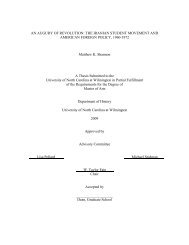HIERARCHAL INDUCTIVE PROCESS MODELING AND ANALYSIS ...
HIERARCHAL INDUCTIVE PROCESS MODELING AND ANALYSIS ...
HIERARCHAL INDUCTIVE PROCESS MODELING AND ANALYSIS ...
Create successful ePaper yourself
Turn your PDF publications into a flip-book with our unique Google optimized e-Paper software.
When t → ∞ we get the following,<br />
0 ≤ N(t) ≤ a 19 (13)<br />
This result tells us that the Nitrate concentration in this model will not exceed<br />
the value of parameter 19 which is the Nitrate average deep concentration. (12) also<br />
tells us that the maximum rate of decline of Nitrate will be that of Parameter 20<br />
which represents the Nitrate maximum mixing rate. This means that the accuracy<br />
of the Nitrate concentration is extremely dependent on how well the parameters are<br />
selected. Since Iron has the same equation structures, the same analysis applies:<br />
dF<br />
dt = [<br />
(a 21 − N)<br />
−<br />
[<br />
P<br />
(a 8 12.0107)<br />
a<br />
{ }}<br />
22<br />
{ ]<br />
E T H2 O<br />
a<br />
max<br />
− E T H2 O(t)<br />
22<br />
E T H2 O max<br />
− E T H2 O min<br />
[<br />
]<br />
(1 − E ice (t))a 0 e (0.06933∗E T H 2 O(t))<br />
M(t) +<br />
]<br />
a 15 D<br />
(a 8 12.0107)<br />
Using the same method as Nitrate the upper found for Iron is<br />
F u (t) = a 21 + Q u e −a 22t<br />
where Q u = F 0 − a 21 ,<br />
Summarizing the bounds we get,<br />
0 ≤ F (t) ≤ a 21 + Q u e −a 22t<br />
(14)<br />
When t → ∞ we get it to be,<br />
∴ 0 ≤ F (t) ≤ a 21 (15)<br />
42
















